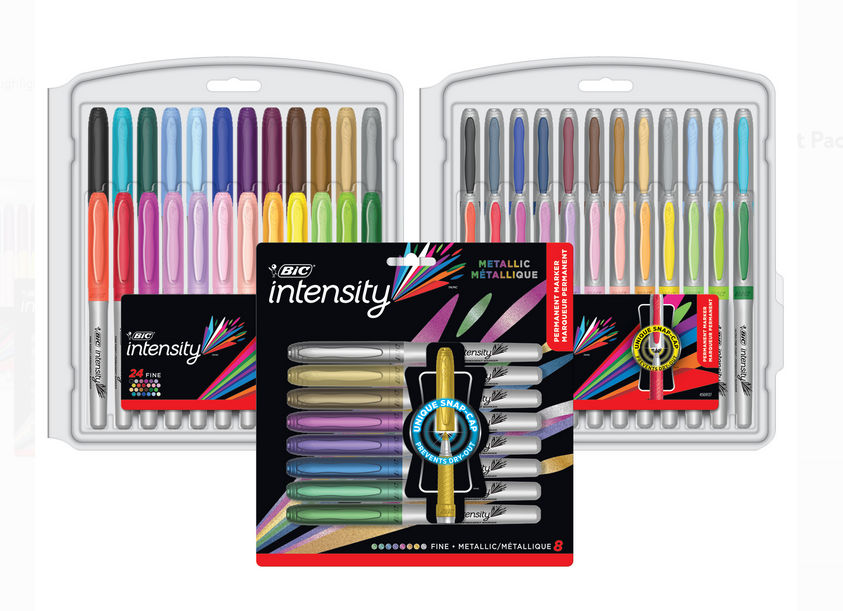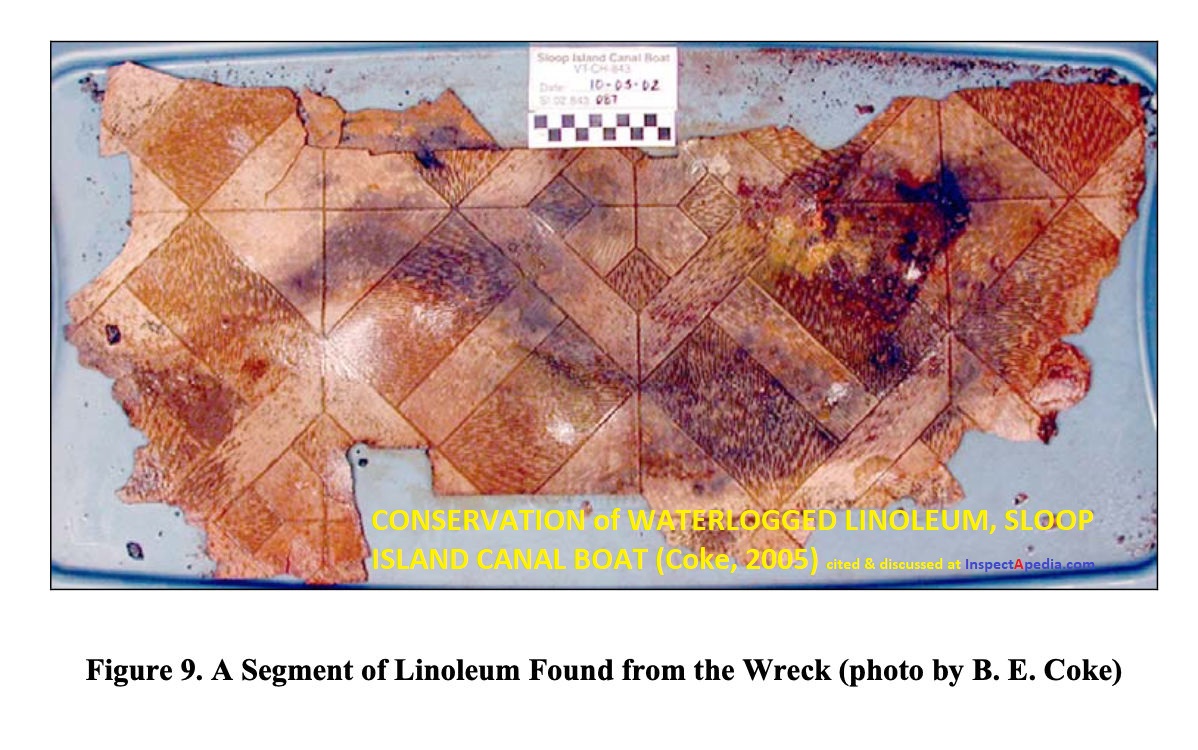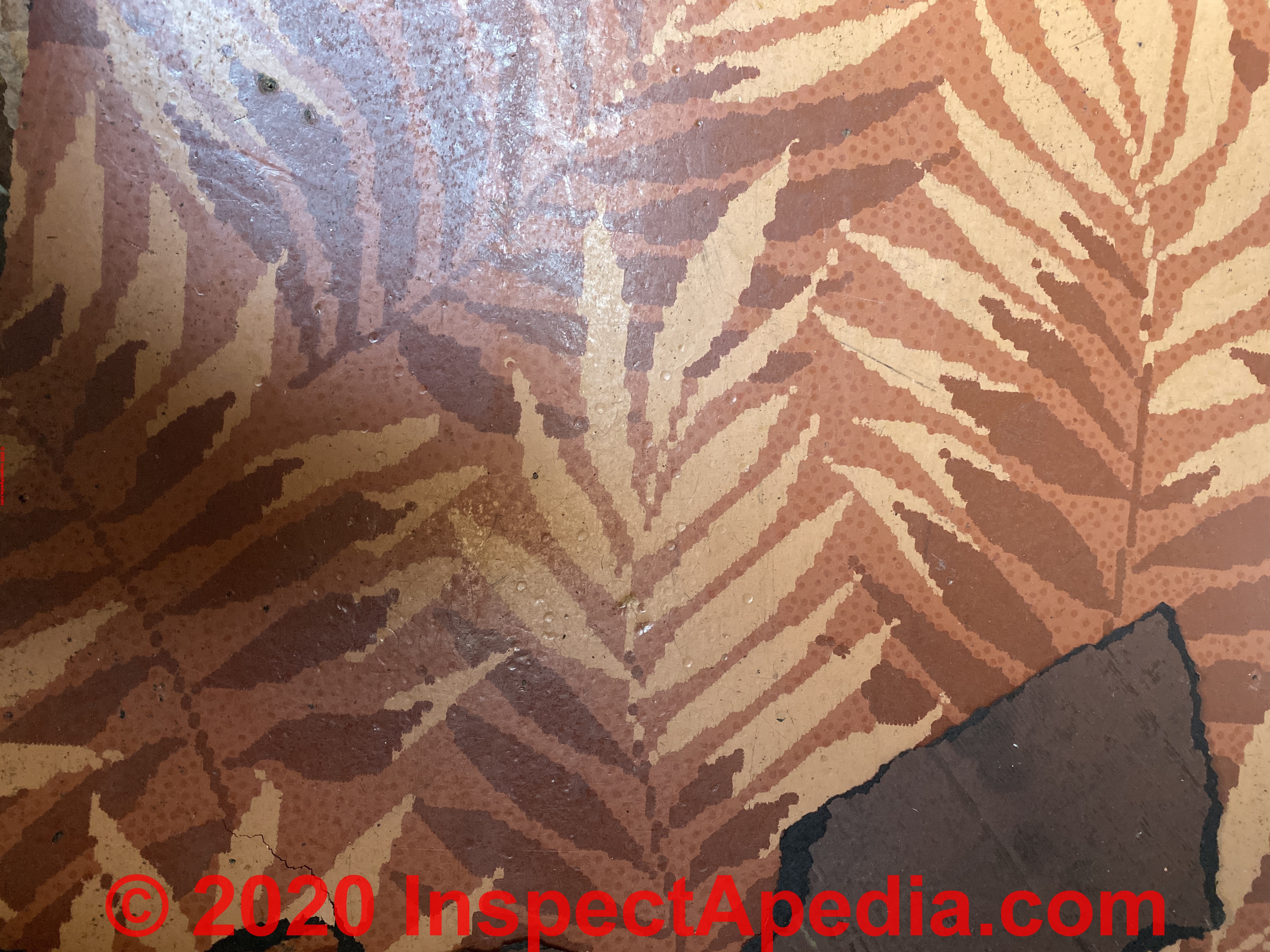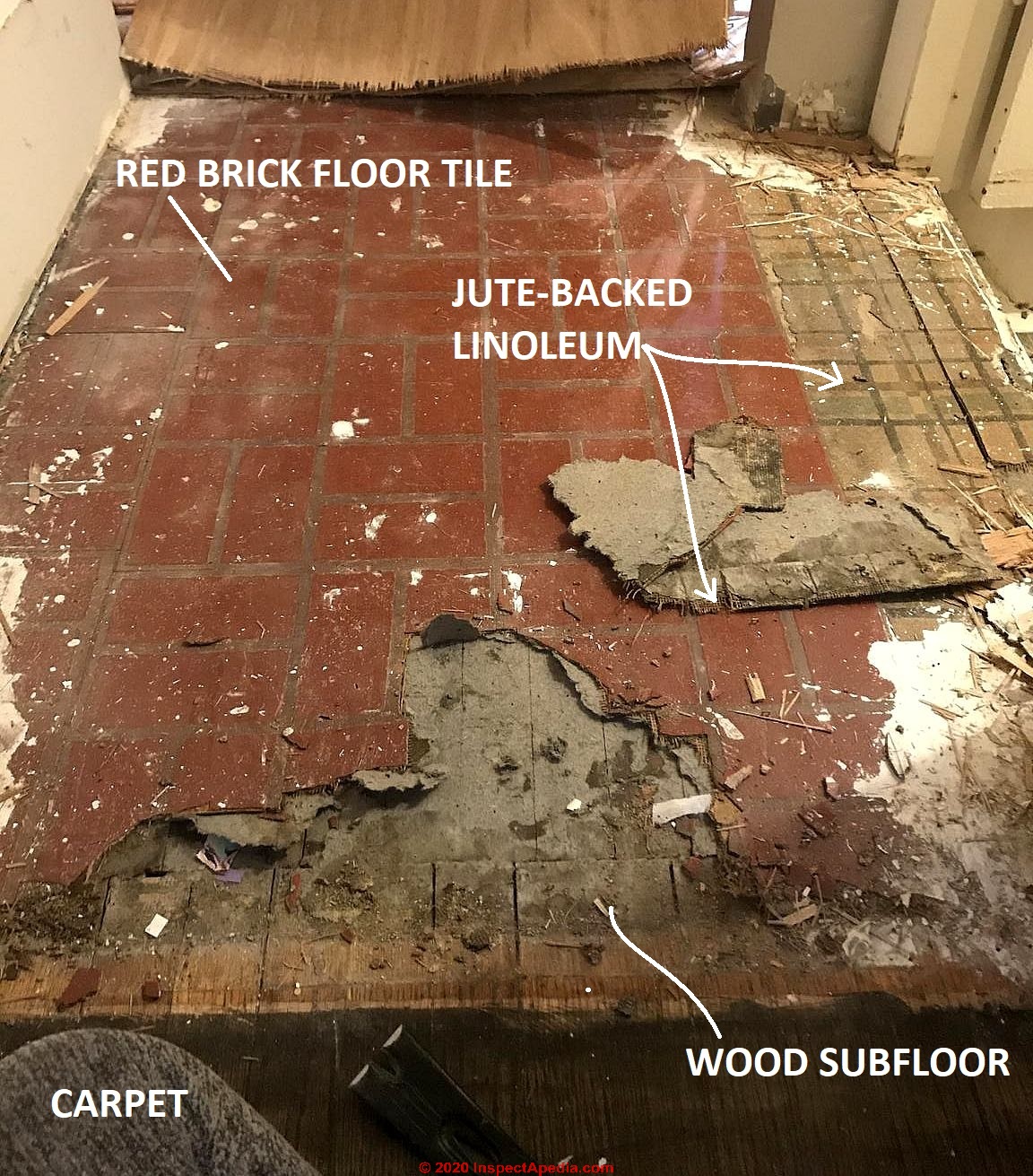 Linoleum Floor Repair
Linoleum Floor Repair
Conservation, Repair & Restoration Procedures for Linoleum Rugs & Sheet Flooring
- POST a QUESTION or COMMENT about the repair or conservation of linoleum flooring
Linoleum Floor restoration, repair or technical conservation.
This article series provides information about linoleum flooring: the history of linoleum, linoleum ingredients, and the properties of linoleum resilient or sheet floor coverings.
InspectAPedia tolerates no conflicts of interest. We have no relationship with advertisers, products, or services discussed at this website.
- Daniel Friedman, Publisher/Editor/Author - See WHO ARE WE?
Linoleum Floor Repair, Restoration & Conservation
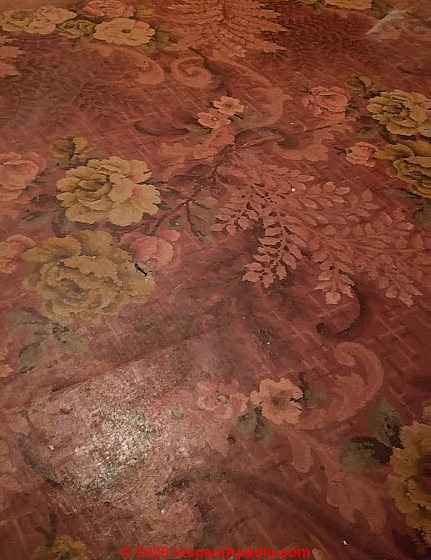
Question: I want to restore or clean up this 1933 Linoleum floral rug
I have pulled up carpet in a 1933 home to find this linoleum carpet.
This linoleum is in great shape and I want assistance to restore it or clean it up!
[Click to enlarge any image]
Moderator reply: Cleaning, maintaining, restoring antique linoleum flooring
First: before doing anything to the linoleum it's important to assess its overall condition, both the exposed surface and the general condition of the backer.
Linoleum was invented in 1860 by Frederick Walton and was intended for use first as a ship deck covering (battleship linoleum up to 1/2" thick).
Earlier, in the 1700s, non-woven floor coverings were made of oil cloth - heavy canvas coated with wax or oils (for water resistance and durability) that were then painted. Understanding how your particular linoleum floor was made and what are its constituents will be helpful in deciding how best to repair and protect it.
If the linoleum is quite fragile and in particular if it is both fragile (cracks, crumbles easily) and is installed over an uneven surface, I'm not optimistic that it's economical to salvage the floor, except in the most important historical cases where a conservator is at work.
If the linoleum design was printed onto the surface (not inlaid in it) AND if the design is missing or worn through, the flooring is not economically restorable by a homeowner.
As you say your floor is in good condition, then taking care not to damage when moving furniture, clear the floor and clean its surface.
The most common advice is to clean the linoleum surface of any wax residues. While some recipes are more aggressive (e.g. using ammonia in solution), it's always best to start with the most-mild, least risky cleaner, such vinegar, dish soap, and clean water, as advised by the Wisconsin Historical Society, quoted below.
When the floor is clean inspect for and repair small cracks using color-matched shellac sticks as a binder/filler/adhesive.
When you're satisfied with the surface appearance, apply a gentle coat of carnauba wax to the surface as a protective coating.
Repair Your Damaged Historic Linoleum
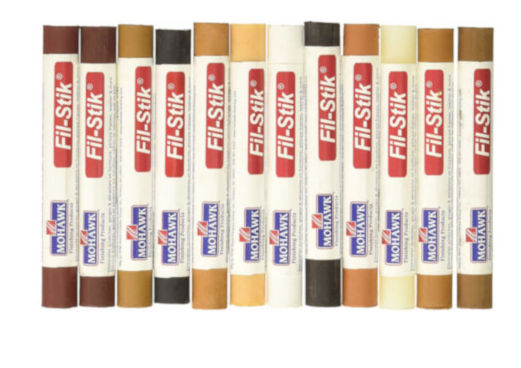 - Adapted & Expanded from Wisconsin Historical Society
- Adapted & Expanded from Wisconsin Historical Society
Follow the three steps below to repair your original linoleum:
Clean the linoleum surface with 1/4 cup of white vinegar and several drops of a liquid dishwashing detergent mixed in a five-gallon bucket of hot water. Rinse the cleaned surface with clear water to remove all the dirt and reveal the appearance of the original linoleum surface.
Repair cracks, small tears and gouges in the surface by filling them with shellac. Most woodworking supply companies on the internet sell shellac sticks for repairing furniture finishes.
These shellac sticks come in a variety of colors that can be mixed to match the affected areas of your linoleum. Follow the manufacturer's directions to install the shellac stick.
Really? Well not quite. Scratch restore sticks are provided in two forms: wax that can actually fill a gouge in a surface, and in felt-tip markers. Felt tip markers or pens contain a combination of coloring pigment, oils, resins, and solvents.
They're not simply "shellac". The furniture repair "system" shown here is by Mowhawk and includes browns, tans, and a reddish-brown cherry color. These waxes are applied by pressure to a clean surface and do not require heat.
Other colors found on a linoleum rug or sheet flooring such as greens, bright reds, orange, yellow, blue, will be harder to find in a furniture repair kit, but you might have some success with very careful use of felt tip markers of those colors.
BIC provides a 24-color permanent ink marker kit intended for craft use. Shop at an office supplier unless you want to buy a box of 56 of these kits at Walmart.
Watch out: some marking pen ink can be removed by soap and water and won't work well as a color fill-in on a linoleum repair. Other felt tip marker ink used by some brands is referred to as "permanent" and thus very difficult to remove.
Use a sharp point marker and "color within the lines" of the repair area on your linoleum rug. Practice working at an edge or an unobtrusive area first.
Other furniture restore repair kits use softer waxes sold in tubes (too soft for flooring) while still other such repair kits require the use of a heated implement - not something I've tried on linoleum.
Wax the linoleum surface with a carnauba-based floor wax, which is similar to car wax. Carnauba is derived from a plant and produces a durable finish. Follow the wax manufacturer's application instructions closely.
- Source: Repairing Linoleum Flooring in Your Historic Building, Wisconsin Historical Society, retrieved 2020/07/19 original source: https://www.wisconsinhistory.org/Records/Article/CS4201
Note: Contact Jen Davel by phone at 608-264-6490 or by email:jen.davel@wisconsinhistory.org
Resources for Linoleum Flooring or Linoleum Rug Restoration
Illustration: fragment of water-logged linoleum from the Lake Champlain wreck of the Sloop Island canal boat (Coke 2005) cited below. The 97 foot long canal boat was excavated in 2002, located off Charlotte, Vermont.
[Click to enlarge any image]
- Abraham, Maike. Die'Messkunst'von Philip Taaffe [PDF] PhD diss., lmu, 2011.
- Armstrong Flooring Products www.armstrong.com/flooring/linoleum.html for a web page listing a store-finder by U.S. zip code.
Armstrong World Industries, Inc. Customer Relations and Technical Services P.O. Box 3001 Lancaster, PA 17604, Tel: 1-800-233-3823 - DOMINION & Other CANADIAN FLOORING ASBESTOS - history of the Dominion Oilcloth & Linoleum Company, Canadian linoleum, sheet flooring, floor tiles, wall covering produced by Dominon & DOMCO, later Tarkett.
- BIC Intensity Permanent Marker Craft Pack, sold at Walmart stores, office supply stores, and crafts suppliers.
- Blackman, Leo, and Deborah Dietsch. LINOLEUM: HOW to REPAIR IT, INSTALL IT, CLEAN IT [PDF] The Old-House Journal. Vol. X., No. 2 (February 1982), pp. 36-38.
Abstract:
The premise of these articles is that despite the fact that linoleum was a popular floor covering beginning at the turn-of-the-century, it is often ignored and little used in restoration. Included here is a summary of linoleum types and their manufacture.
These articles were probably some of the first to acknowledge the importance of linoleum in interior design, and to provide suggestions for repair. - Blackman, Leo, and Deborah Dietsch. "A New Look at Linoleum: Preservation's Rejected Floor Covering." The Old-House Journal. Vol. X, No. 1 (January 1982)
- Carlisle, Alexander M. "Historic linoleum: analysis, cleaning systems, recommendations for preservation." APT bulletin 28, no. 2-3 (1997): 37-43.
Abstract:
A systematic, research-based approach is applied to the preservation of a large quantity of historic linoleum at Canterbury Shaker Village, New Hampshire.
- Carvalho, C., J. de Brito, I. Flores-Colen, and C. Pereira. "Inspection, diagnosis, and rehabilitation system for vinyl and linoleum floorings in health infrastructures." Journal of Performance of Constructed Facilities 32, no. 6 (2018): 04018078.
Abstract:
This paper presents a classification system for the inspection, diagnosis, and rehabilitation of vinyl and linoleum floorings in healthcare infrastructures. First, the identification of the main anomalies affecting these floorings and their probable causes is made. The adequate corresponding in situ diagnosis methods and rehabilitation techniques are also analyzed.
Then, correlation matrices are created, namely: anomalies-causes; interanomalies; anomalies-diagnosis methods; and anomalies-repair techniques. An inspections program was carried out on 101 floorings in six health infrastructures.
With the results obtained in the inspection program, the proposed theoretical system was validated through a statistical analysis. From this validation, anomaly sheets, diagnosis method sheets, and repair technique sheets were obtained. The classification systems, including the correlation matrices, were also validated.
The proposed innovative vinyl and linoleum floorings inspection system intends to help inspectors to standardize their procedures. To the best of the authors’ knowledge, there is no similar system to support the inspection and diagnosis of vinyl and linoleum floorings. - Coke, BobbyeJo Evon (2004). CONSERVATION of WATERLOGGED LINOLEUM [PDF] Master's thesis, Texas A&M University. Texas A&M University. Available electronically from http : / /hdl .handle .net /1969 .1 /1419.
Excerpts:: Linoleum has been around for over a hundred years. With its invention by Frederick Walton in the 1860’s a new means of durable floor covering was introduced to the world. This new invention was promoted as durable, hygienic, and easy to maintain.
In agreement with the Lake Champlain Maritime Museum, a study was commissioned to seek the best means to conserve linoleum from a canal boat excavated in the summer of 2002 in Lake Champlain.
The Sloop Island Canal Boat is part of an excavation project that is studying the ways of life on the lake. Conserving waterlogged linoleum is a new area of study in conservation, and there is very little information dealing with the topic. This study will provide a baseline for the conservation of linoleum.
... With the assistance of the Archaeological Preservation Research Laboratory (APRL ... at Texas A&M University, I accepted the task of researching viable conservation methods.
... Four sources refer to the “conservation” of linoleum: Pennec et al. (1996); Snyder (1995); Carlisle (1997); and Ellermann (2000). Each of these sources gives basic cleaning methods and simple repair solutions, as well as stating the importance of consulting with a trained conservator before attempting anything.
Blackman and Dietsch (1982a) and (1982b), Kahn (1986), and Poore (1984) (articles found in The Old- House Journal); Hutchins (1988) and Von Rosenstiel (1988) (articles found in The Interiors Handbook for Historic Buildings); the C3 Carpet Co. Ltd. (Anonymous 1985);
and the Armstrong Cork Co. all provide the same basic cleaning and simple repair methods. The cleaning and preserving methods given by the resources in this group were inadequate for the specimen in this research study. None dealt with waterlogged linoleum.
- Gooderson, Philip J. Lord Linoleum: Lord Ashton, Lancaster and the Rise of the British Oilcloth and Linoleum Industry. Keele University Press, 1996.
- Cromleigh, Rolland F. FASTENER For FLOOR COVERINGS [PDF] U.S. Patent 946,536, issued January 18, 1910.
Excerpt:
My invention relates to devices for securing together sections of fioor-covering; and it is especially applicable for use with a floor-covering of the character of linoleum. One object of the invention is to provide fasteners that can be used to secure together strips of floor-covering and at the same time leave such covering unattached to the floor so that it can move thereon in accommodating itself to changes in position occasioned by use.
Other objects are to provide a device of the foregoing character that will not perforate the linoleum; to provide a device that will afford a bearing surface upon both sides of the linoleum; and to provide aninexpensive fastener that can be stamped out of sheet material in one piece and in one operation.
The invention contemplates the provision of fasteners to be applied at a number of places along the meeting edges of strips of floor-covering, such as linoleum, to secure the strips together. - Ellermann, Heiko. "Linoleum: Geschichte und Konservierung." PhD diss., Fachhochschule, 1999.
- Grimmer, Anne, HISTORIC BUILDING INTERIORS An Annotated Bibliography [PDF] Internet Archive
- Kaldewei, Gerhard, Nils Aschenbeck, Hilmar Werner, Ingrid Nina Bell, Stadtmuseum Delmenhorst, and Museen der Stadt Delmenhorst. Linoleum: History, Design, Architecture, 1882-2000. Hatje Cantz, 2000.
- Payton, Robert. "The Pagani panels: The conservation and display of painted wall‐mounted linoleum." The Conservator 23, no. 1 (1999): 3-10.
Abstract:
Since its invention in the mid‐19th century, linoleum has proved to be a most resilient and useful product for covering floor surfaces; what is less widely known is its use for covering walls.
This article describes the conservation and remounting of linoleum panels that had been used to cover walls in a fashionable restaurant, Pagani's, in London. Famous diners, from 1874 to 1939, were actively encouraged to sign, paint or scratch graffiti into the painted panels. The history of the manufacture of the linoleum and of its subsequent use in this way is described.
The condition of the panels resulting both from this period in the restaurant and later poor mounting is assessed. The testing and implementation of surface cleaning treatments is discussed in detail. Display options are considered and the method used for remounting described. It is shown that where linoleum is displayed vertically, correct support is needed to prevent distortion. - Pennec, Stéphane Louis, Rhonda Wozniak, Alain Tchapla, and Jean Bleton. "La conservation-restauration de deux linoléums de la Maison Pasteur." In 11th triennial meeting, Edinburgh, Scotland, 1-6 September, 1996: preprints (ICOM Committee for Conservation), pp. 952-960. 1996.
Abstract: Résumé
As part of the commemoration of the centenary of Louis Pasteur's death, his family home at Arbois in the Jura mountains of France was entirely restored, including two linoleum floor coverings. Conservation professionals rarely meet this kind of material in their practice.
Consequently, a historical and chromatographic study of the linoleums was undertaken. Analyses confirmed archival information on their composition, i.e., a mixture of oxidated linseed oil and powdered cork. The restoration entailed cleaning, lining, and reintegration of lacunae. Several tests were carried out prior to selecting the most appropriate methods.
The conservation and restoration of two linoleums from the Maison Pasteur - Mohawk Finishing Products, Fill Stick (Fil-Stik) Furniture Cabinet Touch Up Putty Wax Filler (12-Pack Multi Kit M230-1250) [Shown above, sold at hardware stores and online vendors).
Mohawk, founded in 1948, is now a subsidiary of RPM Wood Finishes Ltd. in Shanghai) in turn owned by RPM Wood Finishes Group, Inc.
Colors:
Color Finish: Medium Brown Walnut, Lt. Red Mahogany / Cranberry, Black / Java, Extra Dark Walnut, Deep Mahogany, Light Walnut, Heritage Oak, Nutmeg, Med. Rock Maple, Natural Tone, Natural, White - Orville W. Carroll, Linoleum Used in Restoration Work,Bulletin of the Association for Preservation Technology,Vol. 1, No. 3 (Dec., 1969), pp. 8-11
Association for Preservation Technology International (APT) DOI: 10.2307/1493351 https://www.jstor.org/stable/1493351 - Simpson, Pamela H. "Linoleum and Lincrusta: The Democratic Coverings for Floors and Walls." Perspectives in Vernacular Architecture 7 (1997): 281-292.
- Slebenbrodt, Michael, and Gerhard Kaldewei, eds. Linoleum: History, Design, Architecture, 1882-2000. Hatje Cantz Pub, 2000.
- Smalley, Dave E. "Care and Maintenance: Linoleum Floors." Hospital Topics 30, no. 3 (1952): 34-53.
- Snyder, Edgar W. "Flexible floor-covering." U.S. Patent 1,262,990, issued April 16, 1918.
- Snyder, Ernest K. "Screen printing machine." U.S. Patent 2,302,152, issued November 17, 1942.
- Snyder, Robert W. "Method for producing mottled sheet material." U.S. Patent 2,908,042, issued October 13, 1959.
- Snyder, Robert W., and Daniel M. Sigman Jr. "Flocked, foamed, embossed surface covering." U.S. Patent 3,591,401, issued July 6, 1971.
- Vanitek Total Furniture Repair System - 13Pc Scratch Restore & Repair Touch-Up Kit - Felt Tip Markers, Wax Stick Crayons & Sharpener, $9.99 at Walmart.com. Vanitek includes wax stick crayons and felt tip markers in a range of tans, brown, cherry, and black.
- Williams, Henry Lionel. Old American Houses and How to Restore Them-1700-1850. Read Books Ltd, 2013.
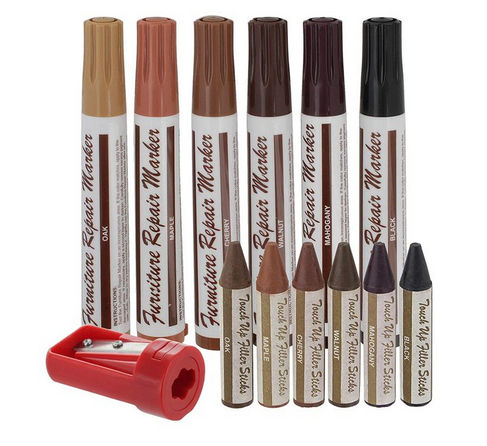
...
Continue reading at CONGOLEUM-NAIRN FLOOR TILES & LINOLEUM or select a topic from the closely-related articles below, or see the complete ARTICLE INDEX.
Or see these
Recommended Articles
- ASBESTOS FLOORING HAZARD REDUCTION
- ASBESTOS TESTING LAB LIST
- ARMSTRONG RUBBER BACKED RUG PATTERNS
- ARMSTRONG SHEET FLOORING 1940 - 1980
- CONGOLEUM-NAIRN FLOOR TILES & LINOLEUM
- DOES THIS FLOORING CONTAIN ASBESTOS? - 5 easy questions help make a reasonable guess -
- DOMINION & Other CANADIAN FLOORING ASBESTOS
- FLOOR, RESILIENT VINYL or CORK
- IDENTIFY SHEET FLOORING TYPE
- LINOLEUM & OTHER SHEET FLOORING
- FLORAL PATTERN LINOLEUM & SHEET FLOORING
- LINOLEUM FLOOR HISTORY
- LINOLEUM ASBESTOS CONTENT?
- LINOLEUM, ASBESTOS FREE Congoleum Gold Seal & Others
- LINOLEUM FLOOR INGREDIENTS
- LINOLEUM FLOORING RESTORATION & REPAIR - Conservation resources
- LINOLEUM "LOOKALIKES" ADHERED to FELT
- MODERN LINOLEUM FLOORS
- WHERE TO BUY LINOLEUM, RUBBER, CORK FLOORS
- RESILIENT SHEET FLOORING ID GUIDE
- SHEET FLOORING POSSIBLE ASBESTOS - 1960-1987
- SWEDISH TARKETT FLOORING POSSIBLE ASBESTOS
Suggested citation for this web page
LINOLEUM FLOORING RESTORATION & REPAIR - Conservation resources - at InspectApedia.com - online encyclopedia of building & environmental inspection, testing, diagnosis, repair, & problem prevention advice.
Or see this
INDEX to RELATED ARTICLES: ARTICLE INDEX to BUILDING FLOORING
Or use the SEARCH BOX found below to Ask a Question or Search InspectApedia
Or see
INDEX to RELATED ARTICLES: ARTICLE INDEX to BUILDING INTERIORS
Or use the SEARCH BOX found below to Ask a Question or Search InspectApedia
Ask a Question or Search InspectApedia
Questions & answers or comments about linoleum floor coverings, age, history, safety, materials, contents.
Try the search box just below, or if you prefer, post a question or comment in the Comments box below and we will respond promptly.
Search the InspectApedia website
Note: appearance of your Comment below may be delayed: if your comment contains an image, photograph, web link, or text that looks to the software as if it might be a web link, your posting will appear after it has been approved by a moderator. Apologies for the delay.
Only one image can be added per comment but you can post as many comments, and therefore images, as you like.
You will not receive a notification when a response to your question has been posted.
Please bookmark this page to make it easy for you to check back for our response.
IF above you see "Comment Form is loading comments..." then COMMENT BOX - countable.ca / bawkbox.com IS NOT WORKING.
In any case you are welcome to send an email directly to us at InspectApedia.com at editor@inspectApedia.com
We'll reply to you directly. Please help us help you by noting, in your email, the URL of the InspectApedia page where you wanted to comment.
Citations & References
In addition to any citations in the article above, a full list is available on request.
- [1] Armstrong, Portugal: Ingredients of Linoleum, web search 03/31/2011, original source: http://www.armstrong.pt/commflreu/es-pt/ingredients.html
- Armstrong Corporation, Corporate History - https://www.armstrongflooring.com/corporate/corporate-history.html - Web Search 05/19/2010
- Our recommended books about building & mechanical systems design, inspection, problem diagnosis, and repair, and about indoor environment and IAQ testing, diagnosis, and cleanup are at the InspectAPedia Bookstore. Also see our Book Reviews - InspectAPedia.
- In addition to citations & references found in this article, see the research citations given at the end of the related articles found at our suggested
CONTINUE READING or RECOMMENDED ARTICLES.
- Carson, Dunlop & Associates Ltd., 120 Carlton Street Suite 407, Toronto ON M5A 4K2. Tel: (416) 964-9415 1-800-268-7070 Email: info@carsondunlop.com. Alan Carson is a past president of ASHI, the American Society of Home Inspectors.
Thanks to Alan Carson and Bob Dunlop, for permission for InspectAPedia to use text excerpts from The HOME REFERENCE BOOK - the Encyclopedia of Homes and to use illustrations from The ILLUSTRATED HOME .
Carson Dunlop Associates provides extensive home inspection education and report writing material. In gratitude we provide links to tsome Carson Dunlop Associates products and services.


